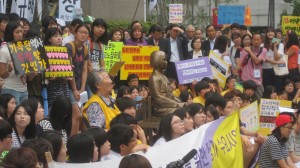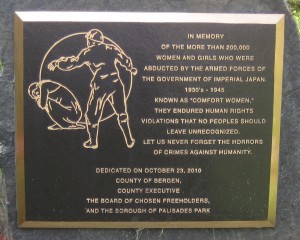On the evening of September 22, 2015, the Board of Supervisors of San Francisco voted unanimously to pass a resolution that states “That the Board of Supervisors of the City and County of San Francisco during the 70th Anniversary of the end of World War II expresses its strong support of creating a public memorial in memory of those girls and women who suffered immeasurable pain and humiliation as sex slaves and as a sacred place for remembrance, reflection, remorsefulness, and atonement for generations to come.”
This was a historic day for San Francisco, the U.S., and the world It marked an important milestone in a series of milestones to try to correct a great injustice and atrocity that occurred more than 70-80 years ago involving hundreds of thousands of women and young girls who were forced into sexual slavery (often euphemistically called comfort women).
How terrifying were the sex slaves’ experiences can be seen from the following remarks by Kim Koon-ja of Korea when she recalled her days as a Japanese sex slave and said that her ordeal was “so painful I tried to kill myself. I choked myself, but got caught and was so badly beaten that it was worse than death itself. There wasn’t a day that passed without tears. My last wish is for the Japanese people to apologize and make compensations.” [1]
It has been a long and difficult struggle to try to correct this great injustice from more than 70-80 years ago. However, a series of milestones during the last 20 years gives us hope that we may see the end of the tunnel in our lifetime. We briefly describe these milestones.
- August 1991: Kim Hap-Soon, a Korean, was the first former sex slave to come out in the open to discuss her experience as a sex slave. There is nothing more convincing that hearing the pain and suffering directly from a victim. The world applauds her for her courage and sacrifice.
- January 8, 1992: The first weekly comfort woman demonstration in front of the Japanese Embassy in Seoul. This weekly demonstration has continued non-stop for more than 23 years, reaching close to 1,200 weekly demonstration, and has become the world’s longest longevity demonstration in history. Here is a photo of the 1,136th weekly demonstration on July 23, 2014 that the author participated in.
(To get a larger-size photo, just click on the photo.)
- September 1995: The United Nations’ Fourth World Conference on Women, held in Beijing, when the issue of sex slaves was a major issue of discussion as a violation of women’s human rights. It was also here that Japanese lawyers and Chinese lawyers first established a collaboration to work together on lawsuits in Japanese courts on sex slaves and slave laborers. This collaboration has continued for 20 years to today.
- Last half of 2007: A series of resolutions was passed by the highest legislative bodies of several Western countries criticizing the Japanese government for not acknowledging and apologizing on the issue of sex slaves from WWII. These resolutions include those passed by the U.S. House of Representatives, the Canadian Parliament, the Lower House of the Dutch Parliament, and the European Parliament. [2]
- October 23, 2010: The small town of Palisades Park (with a population of about 20,000 people and a large number of Korean Americans) dedicated a memorial plaque in front of its township library to remember and recognize the 200,000+ comfort women for the sufferings that they endured, and to press the Japanese government to officially acknowledge and apologize for the inhumane atrocity that the Japanese Imperial Army inflicted on these innocent victims. This was the first U.S. memorial to comfort women. Because the Japanese government, including the Consul General of New York City, visited the Palisades Park’s mayor and other city leaders offering ways Japan can help Palisades Park on the condition that the memorial plaque be removed, an offer that was refused. As a result, this memorial plaque has generated a lot of publicity, including an article in the New York Times, and resulted in the public becoming more aware of the issue of comfort women and that Japan has continued to deny her role in such atrocity during WWII. Similar memorial plaques are now being dedicated in other parts of the U.S. and the world, resulting in more awareness and publicity on this issue.
- July 30, 2013: The city of Glendale, CA put up a Comfort Women Memorial Statue. The Japanese government in collaboration with some local Japanese-American residents and organizations sued the city of Glendale that it has no jurisdiction putting up such a statue, but they lost the law suit.
- Last 20-25 years: A lot of historical research has been done to gather more data on comfort women by historians and researchers in many parts of the world. An important example is the work headed by the husband and wife team of Professor Su Zhi Liang and Professor Chen Lifei and their colleagues at the Research Center on Chinese “Comfort Women” at Shanghai Normal University. They have gathered a large amount of irrefutable evidence of the existence of comfort women and comfort stations in many parts of China. As a matter of fact, their research shows that the normally quoted number of 200,000 comfort women did not include many Chinese comfort women. When the Chinese comfort women are properly included, the number of comfort women is actually close to 400,000.
- September 22, 2015: The resolution passed by the Board of Supervisors of San Francisco discussed at the beginning of this article is just the latest milestone. Similar to Glendale, this resolution also faced challenge by the Japanese government working with some local Japanese-American residents and organizations. The vote was unanimously passed thanks partially to the presence of Yong Soo Lee, a former comfort woman, and the support from various community activists, like former California judges Lillian Sing and Julie Tang who thought of setting up such a memorial 18 years ago after they read Iris Chang’s classic book The Rape of Nanking: The Forgotten Holocaust of World War II when it came out in 1997. .
The resolution to establish a comfort women memorial in San Francisco is just the latest example of people in many parts of the world who feel strongly that it is time to right this great injustice. Furthermore, human trafficking of sex slaves is still happening in many parts of the world, providing more impetus to right this injustice. We hope that this will be accomplished while some of the former comfort women are still alive.
____________________________
[1] A testimony of Ms Kim Koon-ja in front of the U.S. Congress on February 15, 2007 can be found in the document “Protecting the Human Rights of Comfort Women, Hearing before the Subcommittee on Asia, the Facific, and the Global Environment of the Committee on Foreign Affairs, House of Representatives” (pp. 30-36).
[2] For more information on these resolutions, see the article “Reflections on Atrocities in Asia During WWII”: http://www.dontow.com/2007/12/reflections-on-atrocities-in-asia-during-wwii/.


